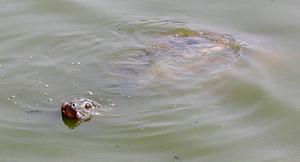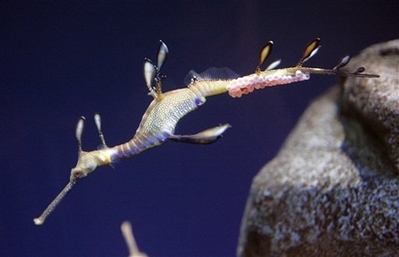Living On ‘The Red Edge’: Rare Form Of Chlorophyll Discovered In Newly Sequenced Bacterium
ScienceDaily (Feb. 11, 2008) — Researchers at Washington University in St. Louis and Arizona State University have sequenced the genome of a rare bacterium that harvests light energy by making an even rarer form of chlorophyll, chlorophyll d. Chlorophyll d absorbs “red edge,” near infrared, long wave length light, invisible to the naked eye.
In so doing, the cyanobacterium Acaryochloris marina, competes with virtually no other plant or bacterium in the world for sunlight. As a result, its genome is massive for a cyanobacterium, comprising 8.3 million base pairs, and sophisticated. The genome is among the very largest of 55 cyanobacterial strains in the world sequenced thus far, and it is the first chlorophyll d –containing organism to be sequenced .
Robert Blankenship. Ph.D., Lucille P. Markey Distinguished Professor in Arts & Sciences at Washington University, and principal investigator of the project, said with every gene of Acaryochloris marina now sequenced and annotated, the immediate goal is to find the enzyme that causes a chemical structure change in chlorophyll d, making it different from primarily chlorophyll a, and b, but also from about nine other forms of chlorophyll.
“The synthesis of chlorophyll by an organism is complex, involving 17 different steps in all,” Blankenship said. “Some place near the end of this process an enzyme transforms a vinyl group to a formyl group to make chlorophyll d. This transformation of chemical forms is not known in any other chlorophyll molecules.”
Blankenship said he and his collaborators have some candidate genes they will test. They hope to insert these genes into an organism that makes just chlorophyll a. If the organism learns to synthesize chlorophyll d with one of the genes, the mystery of chlorophyll d synthesis will be solved, and then the excitement will begin.
Blankenship and his colleagues from both institutions published a paper on their work in the Feb. 4, online edition of the Proceedings of the National Academy of Sciences. The work was supported by the National Science Foundation and also involved collaborators from Australia and Japan. Three Washington University undergraduate students and one graduate student participated in the project, as well as other research personnel.
Harvesting solar power through plants or other organisms that would be genetically altered with the chlorophyll d gene could make them solar power factories that generate and store solar energy. Consider a seven-foot tall corn plant genetically tailored with the chlorophyll d gene to be expressed at the very base of the stalk. While the rest of the plant synthesized chlorophyll a, absorbing short wave light, the base is absorbing “red edge” light in the 710 nanometer range. Energy could be stored in the base without competing with any other part of the plant for photosynthesis, as the rest only makes chlorophyll a. Also, the altered corn using the chlorophyll d gene could become a super plant because of its enhanced ability to harness energy from the sun.
That model is similar to how Acaryochloris marina actually operates in the South Pacific, specifically Australia’s Great Barrier Reef. Discovered just 11 years ago, the cyanobacterium lives in a symbiotic relationship with a sponge-like marine animal popularly called a sea squirt . The Acaryochloris marina lives beneath the sea squirt, which is a marine animal that lives attached to rocks just below the surface of the water. The cyanobacterium absorbs “red edge” light through the tissues of its pal the sea squirt.
The genome, said Blankenship, is ” fat and happy. Acaryochloris marina lies down there using that far red light that no one else can use. The organism has never been under very strong selection pressure to be lean and mean like other bacteria are. It’s kind of in a sweet spot. Living in this environment is what allowed it to have such dramatic genome expansion.”
Blankenship said that once the gene that causes the late-step chemical transformation is found and inserted successfully into other plants or organisms, that it could potentially represent a five percent increase in available light for organisms to use.
“We now have genetic information on a unique organism that makes this type of pigment that no other organism does,” Blankenship said. “We don’t know what all the genes do by any means. But we’ve just begun the analysis. When we find the chlorophyll d enzyme and then look into transferring it into other organisms, we’ll be working to extend the range of potentially useful photosynthesis radiation.’
Animal attack ray trials successful!
Leaping dolphin gives Fla. boaters cuts, bruises
Thu Oct 9, 11:28 PM ET
EDGEWATER, Fla. – A woman is recovering in Florida after a dolphin hit her when it leaped aboard the boat she was in.
The Coast Guard says witnesses called 911 Thursday after seeing the dolphin jump from the Intracoastal Waterway and hit Barbara Howard of Mansfield, Ohio. Howard was sitting in an 18-foot boat with her husband, their daughter and their daughter’s boyfriend.
The Howards say the dolphin jumped about six feet high and landed on the bow. They say it slid in their laps and its thrashing tail knocked them to the deck. Their daughter’s boyfriend rolled the dolphin back into the water.
The husband and wife were treated at a hospital for cuts and bruises and released.
Today's explaination for Junk DNA is…
‘Junk DNA’ Can Explain Origin And Complexity Of Vertebrates, Study Suggests
ScienceDaily (Feb. 12, 2008) Dartmouth College researchers and colleagues from the University of Bristol in the U.K. have traced the beginnings of complex life, i.e. vertebrates, to microRNA, sometimes referred to as ‘junk DNA.’ The researchers argue that the evolution of microRNAs, which regulate gene expression, are behind the origin of early vertebrates.
Vertebrates – animals such as humans that possess a backbone – are the most anatomically and genetically complex of all organisms, but explaining how they achieved this complexity has vexed scientists since the conception of evolutionary theory.
The team studied the genomics of primitive living fishes, such as sharks and lampreys, and their spineless relatives, like the sea squirt. By reconstructing the acquisition history of microRNAs shared between human and mice, the researchers determined that the highest rate of microRNA innovation in the vertebrate lineage occurred before the divergence between the living jawless fishes like the lamprey and the jawed fishes like the shark, but after the divergence of vertebrates from their invertebrate chordate relatives, such as the sea squirt.
Alysha Heimberg of Dartmouth College and her colleagues showed that microRNAs, a class of tiny molecules only recently discovered residing within what has usually been considered ‘junk DNA’, are hugely diverse in even the most lowly of vertebrates, but relatively few are found in the genomes of our invertebrate relatives.
She explained: “There was an explosive increase in the number of new microRNAs added to the genome of vertebrates and this is unparalleled in evolutionary history.”
….
Stop messing with my turtles!
It seems some jerk scientists have stumbled across my private stash of Swinhoe’s turtles and are now hailing their rediscovery. These are my private stash! I’m saving them for a special experiment, but now I have to deal with some conservation nutjobs who haven’t figures out how to mass clone endangered animals. For shame! If I don’t save the wee turtles, who will?

Almost Extinct Turtle Discovered Living In Wild In Northern Vietnam
ScienceDaily (Apr. 19, 2008) — “Swinhoe’s soft-shell turtle” was thought to be extinct in nature. Cleveland Metroparks Zoo has just announced the discovery of a critically endangered turtle in northern Vietnam that previously was thought to be extinct in the wild. Experts from the Zoo’s Asian Turtle Program confirmed that they have identified the only known living specimen of a Swinhoe’s soft-shell turtle (Rafetus swinhoei) in nature.
After three years of searching lakes and wetlands along the Red River in northern Vietnam, researchers sponsored by Cleveland Metroparks Zoo and the Cleveland Zoological Society, turned their focus to a lake just west of Hanoi, where local residents claimed to have occasionally seen the gigantic soft-shell turtle. Field biologist Nguyen Xuan Thuan, with Education for Nature in Vietnam, found and photographed the turtle as it basked on the lake’s surface, allowing scientists to confirm the animal was the extremely rare Swinhoe’s turtle.
This is an incredibly important discovery because the Swinhoe’s turtle is one of the most critically endangered species of turtle in the world,” said Doug Hendrie, the Vietnam-based coordinator of Cleveland Metroparks Zoo’s Asian Turtle Program. “This species has legendary status among the people of Vietnam, so this is perhaps an opportunity for the legend to live on.”
I didn't knock up that sea dragon!

Endangered sea dragon at Ga. aquarium pregnant
Thu Jun 12, 3:19 PM ET
ATLANTA – A weedy sea dragon at the Georgia Aquarium has something to celebrate this Father’s Day. One of the rare creatures is pregnant for only the third time ever at a U.S. aquarium, aquarium officials said. But don’t look for the expectant mom — dads carry the eggs in this family.
The aquarium’s sea dragon has about 70 fertilized eggs — which look like small red grapes — attached to his tail. He is expected to give birth in early to mid-July, said Kerry Gladish, a biologist at the aquarium.
I didn't steal two of the Milky Way's arms
New Images: Milky Way Loses Two Arms
Jeanna Bryner
Staff Writer
SPACE.com Tue Jun 3, 1:15 PM ETST. LOUIS — For decades, astronomers have pictured our galaxy as sporting four major, spiral arms, however new images effectively sever two appendages, revealing the Milky Way has just two major arms.
“We’re not proposing that they change the positions of the arms,” said Robert Benjamin of the University of Wisconsin, Whitewater. “What we’re proposing is a change in the emphasis of the arms.” Benjamin will present his team’s results today here at a meeting of the American Astronomical Society (AAS).
The results are among a handful of presentations at the meeting to paint an evolving picture of our galactic home base.
For instance, other results presented here this week suggest a completely new arm of stars wraps around one side of the galactic bulge. And another group has identified with more accuracy the location and relative distance of the spiral arms.

